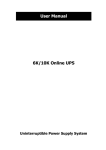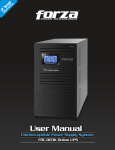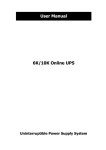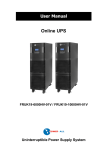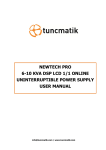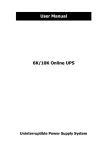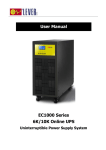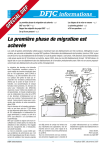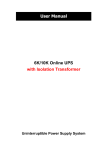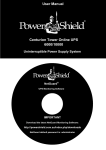Download Forza Power Technologies FDC-006K uninterruptible power supply (UPS)
Transcript
2 W Y ar e ra a nt r y Table of Contents Table of Contents 1. Introduction 1-1. Transportation and storage 1-2. Preliminary steps 1-3. Initial setup 1-4. Important safety instructions 1-5. Standards 2. Installation and operation 2.1 Unpacking and inspection 2.2 UPS front and rear panel views 2.3 Single UPS installation 2.4 Output configuration 2.5 UPS installation for parallel systems 2.6 ForzaTracker monitoring software 3. Advanced operation 3.1 Description of buttons and functions 3.2 LED Indicators and LCD panel 3.3 Audible alarm 3.4 Single UPS Operation 3.5 Parallel operation 3.6. Abbreviations in the LCD Display 3.7 UPS parameter settings 3.8 Operating Mode/Status Description 3.9 Fault codes 3.10 Warning indicators 4. Troubleshooting guide 5. Storage and maintenance 6. Technical specifications 1. Introduction Thank you for purchasing the Forza Atlas FDC 006K/010K Online UPS. To enjoy all the features and benefits of this unit, please read and follow all installation and operation instructions thoroughly before unpacking, installing or operating this device. After you have read this manual, keep it in a safe place for future reference. The information contained in this manual covers the 6000 and 10000 VA uninterruptible power systems, their basic functions, operating procedures, options available and troubleshooting guide. It also includes information on how to ship, store, handle, and install the equipment. 1-1. Transportation and storage • Transport the UPS system only in the original package to protect it against shock and impact. • The UPS must be stored in a dry, well-ventilated area. 1-2. Preliminary steps • Water condensation may occur if the UPS is unpacked in a very cold environment and then moved to a warmer location. • The UPS must be thoroughly dry before being installed. Failure to do so may increase the risk of electric shock. • Do not install the UPS system near water or in moist environments. • To reduce the risk of overheating, do not cover the cooling vents in the UPS housing. • Avoid exposing the UPS to direct sunlight or installing the unit near heat-emitting appliances, such as electric heaters or furnaces. 1-3. Initial setup • Do not connect appliances or equipment that may overload the UPS system (such as big motor-type equipment) to the UPS output sockets or terminal. • Place cables in such a way that no one can step on or trip over them. • Do not block air vents in the housing of UPS. The UPS must be installed in a location with good ventilation. Ensure enough space on each side for ventilation. • The UPS is provided with an earthed terminal. Equipotential earth bonding to the external UPS battery cabinets must be provided if such configuration is used. • The UPS can be installed only by qualified maintenance personnel. • These UPS units are extremely heavy. Caution should be taken in moving and positioning equipment. • An appropriate disconnect device as short-circuit backup protection should be provided in the building wiring installation. • An integral single emergency switching device which prevents further supply to the load by the UPS in any mode of operation should be provided in the building wiring installation • Connect the earth before connecting the unit to the building wiring terminal. • Installation and wiring must be performed in accordance with local electrical regulations and laws. 1-4. Important safety instructions • Do not disconnect the earth conductor cable on the UPS or the building wiring terminals at any time since this would cancel the protective earth of the UPS system and of all connected loads. • The UPS system features its own, internal current source (batteries). The UPS output sockets or output terminals block may be electrically live even if the UPS system is not connected to the building wiring outlet. • In the event of an emergency, press the OFF button and disconnect the power cord from the AC mains to properly disable the UPS. • Do not allow any kind of liquid or foreign object to enter this UPS unit. Do not place beverages or any other containers with liquid on or nearby the unit. • The UPS can be operated by any individuals with no previous experience. 1-5. Standards * Safety IEC/EN 62040-1 * EMI Conducted emission IEC/EN 62040-2 Category C3 Radiated emission IEC/EN 62040-2 Category C3 * EMS ESD IEC/EN 61000-4-2 Level 4 RS IEC/EN 61000-4-3 Level 3 EFT IEC/EN 61000-4-4 Level 4 SURGE IEC/EN 61000-4-5 Level 4 CS IEC/EN 61000-4-6 Level 3 Power-frequency magnetic field IEC/EN 61000-4-8 Level 4 Low frequency signals IEC/EN 61000-2-2 Warning: This product is intended for commercial and industrial applications. Installation in the proper environment is required. 2. Installation and operation The Forza Atlas series is offered in two different models, as shown in the table below. Model Capacity FDC-006K 6000 VA (4800 W) FDC-010K 10000 VA (8000 W) 2-1. Unpacking and inspection Remove the UPS from its package and make sure that all the following items are included: • One UPS unit • One user manual (digital copy in CD) • One monitoring software CD (ForzaTracker) • One USB cable Warranty certificate Carefully inspect the UPS to check for any damages that may have occurred during shipping. Should any evidence of damage be found or if some parts are missing, do not turn the UPS on; you must immediately notify the carrier or dealer where you purchased the unit. 2-2. UPS front and rear panel views Front view Rear panel diagram 6K 6K/10K Diagram 1: Rear Panel Overview Diagram 2: Input/Output Terminal 1. RS-232 communication port 2. USB communication port 3. Emergency power off (EPO) connector 4. Parallel connection port 5. Parallel port intelligent slot 6. Charger fan 7. Power stage fan 8. Maintenance bypass switch 9. Input circuit breaker 10. Isolation transformer fan 11. Input/Output terminal (Refer to diagram 2 for details) 12. Output terminal 1 13. Output terminal 2 14. Utility input terminal 15. Non-isolated neutral terminal. 2-3. Single UPS installation Installation and wiring must be performed by qualified personnel, and in accordance with the local electrical regulations and codes. Also, you must observe the following instructions: 1) Make sure the mains wire and breakers in the building are enough for the rated capacity of the UPS to avoid the hazards of electric shock or fire. Note: Do not use a wall receptacle as the input power source for the UPS, as its rated current is less than the UPS maximum input current. Failure to do so may result in a broken or burned out receptacle. 2) For safety considerations, turn off the mains switch in the building before installation. 3) Turn off all the devices before connecting them to the UPS. 4) Wiring sizes should be installed in accordance with the following table: Model Wiring specification (AWG) Ground 10 Non-isolated Neutral 10 8 8 8 Input Output 6K 10 10K 8 Battery 10 Diagram 1: Rear Panel Overview Note 1: The cable for 6K should be able to withstand currents of over 40A. It is recommended to use a 10AWG or thicker wire for safety and efficiency. Note 2: The cable for 10K/ should be able to withstand currents of over 63A. It is recommended to use an 8AWG or thicker wire for safety and efficiency. Note 3: For single model, it is not necessary to connect the non-isolated neutral terminal. Note 4: The color selection of wires should be made according to the local electrical codes and regulations. 5) Remove the terminal block cover on the rear panel of UPS. Proceed to connect the wires according to the following terminal block diagrams: (Make sure to attach the earth wire first when connecting the wires. When removing the wiring, make sure to remove the earth wire last). Input Neutral Input Line Output 2 Neutral Output 2 Line Non-isolated Neutral Output 1 Line Output 1 Neutral Terminal block wiring diagram of 6K /10K Note 1: Make sure that the input and output wires and the input and output terminals are connected tightly. Note 2: There are two output terminal configurations to meet customers’ diverse requirements for serial or parallel connection. Please refer to section 2.4. Note 3: Install the leak current protective breaker at the output power distribution panel of the UPS, if necessary. 6) Put the terminal block cover back in the rear panel of the UPS Warning: • For safety considerations, switch all power off using the main switch before installation. Note: The battery breaker must also be set to OFF before installing the battery pack. • Pay close attention to the rated battery voltage marked on the rear panel. If you want to change the number of batteries, please make sure you modify the settings accordingly. A connection with the wrong battery voltage may cause permanent damage to the UPS. Make sure the voltage of the battery pack is correct. • Pay close attention to the polarity markings on the external battery terminal block, and make sure to match the correct battery polarity of the cells. Wrong connection may cause permanent damage to the UPS. • Make sure the protective earth ground wiring is correctly installed. The wire current specification, color, position, connection and conductance reliability should be checked carefully. • Make sure the utility input and output wiring is correct. The wire current specification, color, position, connection and conductance reliability should be checked carefully. Make sure the L/N wiring is correct, not reverse and short-circuited. 5) Remove the terminal block cover on the rear panel of UPS. Proceed to connect the wires according to the following terminal block diagrams: (Make sure to attach the earth wire first when connecting the wires. When removing the wiring, make sure to remove the earth wire last). 2-4. Output configuration Option 1: L1 N1 L2 N2 L N To Load 1 To Load 2 There are 2 sets of low-voltage outputs (104/110/115/120V) on L1-N1 & L2-N2. Each set is able to provide 50% of the UPS rated current. Connect one load to L1-N1 and the other load to L2-N2. Option 2: L1 N1 L2 N2 L N To Load After connecting L1&L2 and N1&N2, it becomes one low-voltage output (104/110/115/120V) at L1-N1 for 100% of the UPS rated current. Connect load to L1-N1 or L2-N2. Option 3: L1 N1 L2 N2 L N To Load After connecting N1 and L2, it becomes one high-voltage output (208/220/230/240V) at L1-N2 for 100% of the UPS rated current. Connect load to L1-N2. Option 4: L1 N1 L2 N2 L N To Load 1 To Load 2 To Load 3 After connecting N1&L2, it becomes three outputs, one high-voltage output (208/220/230/240V) at L1-N2 and two lowvoltage outputs (104/110/115/120V) at L1-N1 & L2-N2. However, there is a limit for current rating at L1-N1 & L2-N2: 25A for 6Kmodel and 42A at 10K model. You must connect the load taking into account such limits. Please read the notes before installation. Connect the low-voltage load to L1-N1 and L2-N2, and connect the high-voltage load to L1-N2. Note1: If any load current in L1-N1 or L2-N2 is higher than 25A in 6K model and 42A in 10Kmodel, the UPS will still operate normally without overload warning because the total load is under the specified limit. However, the high current can damage the isolation transformer due to overheat caused by the high current. Hence, the installation must be done with a technician to ensure that the load current will not exceed this limitation. Note 2: When connecting to low-voltage and high-voltage at the same time as described in option 4, the L1-N1 & L2-N2 will feed low-voltage loads in non-isolated status because high-voltage is being generated by shorting N1-L2. If keeping a connected load in isolated status is required, we recommend that you may only use two low-voltages at L1-N1 or L2-N2 like illustrated in option 1, and also make sure that the total current in L1-N1 or L2-N2 does not exceed the value specified in Note1. 2-5. UPS installation for parallel systems If the UPS is only available for single operation, you may skip this section to the next. 1) Install wiring as instructed in the UPS installation section. 2) Connect the output wires of each UPS to an output breaker. 3) Connect all output breakers to a major output breaker. The major output breaker will then directly connect to the loads. 4) Each UPS must be connected to an independent battery pack. Note: The parallel system cannot run on a single battery pack. Otherwise, it may cause system permanent failure. 5) Remove the cover of the parallel current cable port on the UPS. Connect each UPS one by one with the parallel cable and share current cable. Reattach the cover. 6) Refer to the following wiring diagrams: N L Input Line L N L Output 2 Line N Output 1 Neutral L Output 1 Line N Output 2 Neutral Non-isolated Neutral N UPS2 L N N N L N UPS1 N Input Neutral Diagram 1: Power cable connections Parallel communication port connection Share current cable connection Diagram 2 Parallel communication and parallel current connections. 2-6. ForzaTracker monitoring software ForzaTracker is a new generation of UPS monitoring software, which provides user-friendly interface to monitor and control your Uninterruptible Power System. This unique software provides safe auto-shutdown for multi-computer systems during power failures. With this software, users can monitor and control any UPS on the same LAN no matter how far they might be from the UPS. Installation procedure for Windows users: 1. Use the supplied CD or go to the website: http://www.forzaups.com. 2. After clicking the software icon, choose the required operation system. 3. Follow the on-screen instructions to install the software. 4. When you finished downloading all required files, enter the serial No (Installation Password): 5242-87f6-64re-di8d-986u to install the software (include the hyphens). 5. In order to access as Administrator, input the password: 111296. 6. When your computer restarts, the management software will appear as a light blue round icon located in the system tray, near the clock. For Mac users, please refer to the ForzaTracker QIG inside the Mac folder. 3. Advance operation 3-1. Description of buttons and functions Button Function ON/Enter Button Turns on the UPS: Press and hold this button over 0.5 second to turn on the UPS. Enter Key: Press this button to confirm the selected settings of the configuration menu. OFF/ESC Button Turns off the UPS: Press and hold this button for 0.5 second to turn off the UPS. Esc key: Press this button to return to the last setting of the configuration menu. Test/Up Button Mute/Down Button Battery test: Press and hold this button for 0.5 second to test the battery status while in AC mode, or CVCF mode. UP key: Press this button to display the next selection in the configuration menu. Mutes the alarm: Press and hold the button for 0.5 second to mute the buzzer. Please refer to sections below for details. Down key: Press this button to display previous selection in the configuration menu. Test/Up + Press and hold these two buttons simultaneously for 1 second either to enter Mute/Down or exit the menu settings. Button * CVCF stands for converter mode. 3-2. LED Indicators and LCD Panel There are 4 LEDs on front panel to show the UPS working status: Mode LED Bypass Line UPS startup Bypass mode AC mode Battery mode CVCF mode Battery Test ECO mode Fault Note: • means LED is illuminated LCD panel: means LED is not illuminated. Battery Fault Display Function Backup time information Provides a digital indication of the battery discharge time. H: hours, M: minutes, S: seconds Fault information Indicates that a warning or fault has occurred. Displays the fault codes, listed in detail in the sections below. Mute operation Indicates that the UPS alarm has been disabled. Output & battery voltage information Provides an indication of the output voltage, frequency or battery voltage. VAC: output voltage, VDC: battery voltage, Hz: frequency Load information Indicates the load level at 0-25%, 26-50%, 51-75%, and 76-100%. Overload indication. Indicates the load or the output is short. Programmable output information Indicates that the programmable outputs are working. Mode operation information Indicates that the UPS is connected to the mains. Indicates the battery is in working status. Indicates the bypass circuit is in working status. Indicates the ECO mode is enabled. Indicates the Inverter circuit is working. Indicates the output connector is working properly. Battery information Indicates the battery is charged at 0-25%, 26-50%, 51-75%, and 76-100% of its capacity. Indicates the battery is not connected. Low battery and low voltage indicator. Input & battery voltage information Indicates the input voltage or frequency or battery voltage. VAC: Input voltage, VDC: battery voltage, Hz: input frequency There are 4 LEDs on front panel to show the UPS working status: 3-3. Audible alarm Description UPS status Bypass mode Battery mode Fault mode Warning Overload Low battery Battery unconnected Over charge EPO enable Fan failure/Over temperature Charger failure IP fuse blown Overload 3 times in 30min EPO status Cover of maintenance switch is open Parallel protection Fault Bus start failure Bus over Bus under Bus unbalance Inverter soft start failure High Inverter voltage Low Inverter voltage Inverter output short circuited Negative power fault Battery SCR is short circuited Inverter relay is short circuited Parallel communication failure Parallel output current unbalance Over temperature CPU communication failure Overload Buzzer status Beeps once every 2 minutes Beeps once every 4 seconds Beeps continuously Mute Yes Beeps twice every second Beeps once every second No Beeps continuously Yes 3-4. Single UPS Operation 1. Turn on the UPS with utility power (in AC mode) 1) Turn on the UPS with utility power supply (On-grid /AC mode). After making sure that the power supply connection is correct, set the input breaker to the “ON” position first. At this point, the fan will start running while the UPS supplies power to the load via the bypass. The UPS is now operating in Bypass mode. Note: When the UPS is in Bypass Mode, the output voltage will directly power the load from utility after you have switched on the input breaker. In Bypass Mode, the load is not protected by the UPS. To protect your load devices, you should turn on the UPS. 2) Press and hold the ON button for 0.5 second to power on the UPS. The buzzer will beep once. 3) After a few seconds, the UPS will enter into the AC mode. In case of abnormal utility power, the UPS will transfer to battery mode operation to provide uninterrupted power to the outlets. Note: In battery mode, the UPS will shut down automatically when the remaining charge is low. Once the utility power is restored, the UPS will restart automatically in AC mode. 2. Turn on the UPS without utility power (Battery mode) 1) Press and hold the “ON” button for 0.5 second to power on the UPS. The buzzer will beep once. 2) After a few seconds, the UPS will be turned on and begin operating on “off-grid” or Battery mode. 3. Connecting devices to the UPS After the UPS is turned on, you can connect devices to the unit. 1) Turn on the UPS first and then start switching “on” one load at a time, only after all of them have been plugged into the unit. The total load level will be displayed on the LCD panel. 2) Should you need to connect inductive loads, such as a monitor or a laser printer to the UPS, the start-up power should be used for calculating the capacity of the UPS, as energy consumption increases during initial power on. 3) If the UPS is overloaded, the buzzer will beep twice each second. 4) In the event of an overload, all unnecessary loads must be removed one by one, to lower the total loads connected to the UPS to less than 80% of its nominal power capacity to prevent overload condition. 5) If the overload time exceeds the time specified in AC mode, the UPS will automatically transfer to Bypass mode. After the overload is removed, the UPS will return to AC mode. If the overload time exceeds the time specified in Battery mode, the UPS will transfer to fault status. At this time, if bypass is enabled, the UPS will supply power to the loads using the bypass mode. If the bypass function is disabled or the input power is not within the bypass acceptable range, the output power will be cut off immediately. 4. Charging the batteries 1) Once the UPS is connected to utility power, the unit will charge the batteries automatically, except if the USP is running in Battery mode or while the battery self-test is in progress. 2) It is recommended to charge the batteries at least 10 hours before use to ensure proper backup time. 3) Make sure battery number setting on the control board is consistent with the actual connection. 5. Battery mode operation 1) When the UPS is in Battery mode, the buzzer will beep according to the battery capacity. a. If the battery capacity is more than 25%, the buzzer will beep once every 4 seconds. b. If the battery voltage drops to the alarm level, the buzzer will beep once every second to indicate that the battery has dropped to its lowest capacity, and that the UPS will soon shut down automatically. Shutting down non-critical loads at this point will prolong the backup time. If the programmable timer function is enabled, the UPS will shut off programmable output terminals automatically. Note: There is the risk of data loss or load failure if battery runtime is exceeded. 2) To silence the buzzer sound in Battery mode, press the Mute button. 3) The backup time vary depending upon environment conditions and load types. 4) When the backup time is set at 16.5 hours (LCD panel default value), the UPS will shut down automatically to protect the battery after the discharging period of 16.5 hours is completed. This battery discharge protection can be enabled or disabled using the LCD panel control. 6. Testing the batteries 1) To check the battery status when the UPS is running in AC mode/CVCF mode/ECO mode, press the Test button to initiate the self-test. 2) To maintain the system reliability, the UPS will perform the battery self-test automatically on a periodic basis. The default setting for the battery self test is once per week. 3) Battery self-test interval can also be set through the monitoring software. 4) If the UPS is in battery self-test Mode, the LCD Display and buzzer indication will be the same as in battery mode, except that the battery LED is flashing. 7. Turn off the UPS with utility power in AC mode 1) Turn off the inverter of the UPS by pressing the OFF button for at least 0.5 second. The buzzer will beep once and the UPS will go into Bypass mode. Note 1: If the UPS has been set to enable the bypass output, it will bypass voltage from utility power to the output terminal even though the UPS (inverter) has been turned off. Note 2: After turning off the UPS, please beware that the UPS is operating in Bypass mode and there is a risk of power loss for connected devices. 2) In Bypass mode, output voltage of the UPS is still present. In order to shut off the output voltage, switch off the input breaker to the UPS. A few seconds later, there will be no display shown on the LCD panel while the UPS is now completely turned off. 8. Turn off the UPS without utility power supply in Battery mode 1) Turn off the UPS by pressing the OFF button for at least 0.5 second. The buzzer will beep once. 2) The UPS power will shut off output and there will be no indication showing on the display panel. 9. Muting the buzzer 1) To silence the buzzer, press the Mute button for at least 0.5 second. If you press it again, the buzzer will be enabled. 2) Some warning alarms cannot be muted unless the error that triggered them is fixed. 10. Operation in warning status 1) When the Fault LED flashes and the buzzer beeps once every second, it means that the UPS is experiencing operation issues. Fault Codes are available via the LCD Panel. Refer to the Trouble Shooting table for additional details. 2) Some warning alarms cannot be muted unless the error that triggered them is fixed. 11. Operation in fault mode 1) When the Fault LED illuminates and the buzzer beeps continuously, it means that there is a fatal error in the UPS. Fault Codes are available via the LCD Panel. Refer to the Trouble Shooting table for additional details. 2) Check the loads, wiring, ventilation, utility, battery and so on when a fault occurs. Do not try to turn on the UPS again before solving the problems. If the issues persist, contact the dealer or service personnel immediately. 3) In case of emergency, disconnect the UPS from the utility, external battery, and output immediately to avoid danger. 12. Changing battery numbers 1) This operation should only be performed by trained and qualified technicians. 2) Turn off the UPS. If the load cannot be shut down, remove the cover from the maintenance bypass switch on the rear panel of the unit, and slide the maintenance switch to the BPS position. 3) Switch off the input breaker. 4) Remove the UPS cover. Modify the jumper on the control board to set the battery numbers and disconnect the battery wire. After completing the changes, replace the UPS cover. Note: JP1 setting on the control board: Jumper placed on pins 5 & 6 and pins 7 & 8 for 20 pieces of batteries. Jumper placed on pins 5 & 6 or pins 7 & 8 for 19 pieces of batteries. Keep every pin open for 18 pieces of batteries. 5) Switch on the input breaker and the UPS will enter Bypass mode. If the UPS is in maintenance Bypass mode, turn the maintenance switch to the “UPS” position before turning on the system. 3-5. Parallel operation 1. Parallel system connection 1) Make sure all of the UPSs are designed for parallel operation and that all the wiring is done properly. 2) Turn off the input and output breakers of each UPS. 3) Remove all the maintenance bypass covers and change the maintenance switches from UPS to BPS. When done, replace the maintenance bypass cover. With a multimeter, measure the L1-N1 and L2-N2 voltage difference between each UPS. If the voltage difference is less than 2V, it means all connections are correct. If the difference is larger than 2V, check if the wiring has been done correctly. 4) Turn on the input breakers of each UPS in the parallel systems. Before turning on each UPS, check if PAR001~PAR003 are displayed in each UPS sequentially. If no “PAR××” exists in any UPS, check if the parallel cables are correctly connected. 5) Turn on each UPS in sequence and make sure that AC mode LED or Battery mode LED display is lit in each UPS. Using a multimeter, measure the output voltage of each UPS to make sure the voltage difference is less than 2V (typical 1V). If the difference is larger than 2V, check that parallel cables and/ or parallel current cables are connected properly. 6) Turn off each UPS in sequence. After all of the UPS are transferred to Bypass mode, turn on the output breaker of each unit. 7) Turn on the UPSs in the AC mode. Parallel system connections and configuration should now be complete. 2. Adding one new unit into the parallel system 1) You cannot add one new unit into the parallel system while the whole system is running. First, all loads and each UPS in the system must be shutdown 2) Make sure all of the UPS are parallel models, and follow the wiring scheme shown earlier in this manual. . 3) Install the new UPS and follow instructions in the previous section for proper connection, testing and startup. 3. Removing one unit from the parallel system There are two methods that can be used to remove one UPS from the parallel system: First method: 1) Press the OFF button twice for about 0.5 second each. The UPS will enter into bypass mode without output. 2) After turning off the output breaker, do the same with the input breaker of the UPS. 3) After the UPS shuts down, remove the parallel cable and parallel current cable. You can now remove the unit out from the parallel system. Second method: 1) If the bypass is abnormal, you cannot remove the UPS without interruption. You must first power down the load and shut down the UPS system. 2) Enable the Bypass setting in each UPS and then power off the running UPS. All UPS units in the parallel system will transfer to Bypass mode. Remove all maintenance bypass covers and change the maintenance switches from UPS to BPS. Next, turn off input breakers and battery breakers. 3) Remove the desired UPS. 4) Turn on the input breaker of the remaining UPS and the system will transfer to Bypass mode. 5) Set the maintenance switches from BPS to UPS and replace the maintenance bypass covers. Turn on the remaining UPS and finish the parallel system connections. Warning: (parallel system only) • Before turning on the parallel system to activate the inverter, make sure that every maintenance switch on the UPS is in the same position. • When the parallel system is turned on to operate through the inverter, do not change the maintenance switch of any unit. 3-6. Abbreviations on the LCD display Abbreviation Display content Meaning ENA Enable DIS Disable ATO Auto BAT Battery NCF Normal mode (not CVCF mode) CF CVCF mode SUB Subtract ADD Add ON On OFF Off FBD Not allowed OPN Allow RES Reserved PAR Parallel 3-7. UPS parameter settings Three parameters need to be configured in order to set up the UPS. Refer to following diagram. Parameter 1 Parameter 1: it is used for the different configuration options. There are 15 programs to set up. Refer to the table below. Parameter 2 and parameter 3: they represent the setting options or values of each program. Parameter 2 Parameter 3 List of the 15 programs for parameter 1: Code Description Bypass AC ECO Battery CVCF Battery test 01 Output voltage Y 02 Output frequency Y 03 Voltage range for bypass Y 04 Frequency range for bypass Y 05 ECO mode enable/disable Y 06 Voltage range for ECO mode Y 07 ECO mode frequency range setting Y 08 Bypass mode setting Y Y 09 Battery backup time setting Y Y Y Y Y Y 10 Reserved /Programmable output setting** Y Y Y Y Y Y 11 Reserved /Shutdown point for programmable output** Y Y Y Y Y Y 12 Hot standby function enable/disable Y Y Y Y Y Y 13 Battery voltage adjustment Y Y Y Y Y Y 14 Charger voltage adjustment Y Y Y Y Y Y 15 Output voltage adjustment Y Y Y *Y means that this program can be set in this mode. **There are two kinds of output transformers: ratio of 1:1 and 2:1 respectively. Programmable output function is only available for the output transformer with a ratio of 1:1. Note: All parameter settings will be saved only when UPS shuts down normally with internal or external battery connection. (Normal UPS shutdown means turning off input breaker in bypass/no output mode). 01: Output voltage settings Interface Setting Parameter 3: Output voltage You may choose the following output voltage in parameter 3: 208: The output voltage is 208VAC 220: The output voltage is 220VAC 230: The output voltage is 230VAC 240:The output voltage is 240VAC 02: Output frequency settings Interface 60 Hz, CVCF mode 50 Hz, Normal mode ATO Setting Parameter 2: Output frequency To set the output frequency, choose any of the following three options in parameter 2: 50.0Hz: The output frequency is set to 50.0Hz. 60.0Hz: The output frequency is set to 60.0Hz. ATO: When selected, the output frequency will be set according to the latest normal utility frequency. If it ranges from 46Hz to 54Hz, the output frequency will be 50.0Hz. If it ranges from 56Hz to 64Hz, the output frequency will be set at 60.0Hz. ATO is the default setting. Parameter 3: Frequency mode Enables you to set the output frequency in either CVCF mode or no CVCF mode. You may choose any of the following two options in parameter 3: CF: Sets the UPS in the CVCF mode. If selected, the output frequency will be fixed at 50Hz or 60Hz according to the setting in parameter 2. The input frequency could range from 46Hz to 64Hz. NCF: Sets the UPS to normal mode (not CVCF mode). If selected, the output frequency will synchronize with the input frequency within 46~54 Hz at 50Hz or within 56~64 Hz at 60Hz according to the setting defined in parameter 2. If 50 Hz is selected in parameter 2, the UPS will transfer to battery mode provided the input frequency does not fall within 46~54 Hz range. If 60Hz is selected in parameter 2, the UPS will transfer to battery mode provided the input frequency does not fall within the 56~64 Hz range. *If ATO is selected in Parameter 2, Parameter 3 will show the current frequency 03: Voltage range for bypass Interface Setting Parameter 2: Sets the acceptable low voltage for bypass operation. Setting ranges from 110V to 209V, with a default value of 110V. Parameter 3: Sets the acceptable high voltage for bypass operation. Setting ranges from 231V to 276V, with a default value of 264V. 04: Frequency range for bypass Interface Setting Parameter 2: Sets the acceptable low frequency for bypass operation. 50 Hz system: Setting ranges from 46.0Hz to 49.0Hz. 60 Hz system: Setting ranges from 56.0Hz to 59.0Hz. The default value is 46.0Hz/56.0Hz. Parameter 3: Sets the acceptable high frequency for bypass operation. 50 Hz: Setting ranges from 51.0Hz to 54.0 Hz. 60 Hz: Setting ranges from 61.0Hz to 64.0Hz. The default value is 54.0Hz/64.0Hz. 05: ECO mode enable/disable Interface Setting Parameter 3: Enables or disables the ECO feature. You may choose between the following two options: DIS: disables the ECO feature ENA: enables the ECO feature When the ECO feature is disabled, the voltage and frequency range can still be set for this mode, however, such parameters will take effect only if the ECO function has been enabled. 06: Voltage range for ECO mode Interface Setting Parameter 2: Sets the low voltage point in ECO mode. This setting ranges from 5% to 10% of the nominal voltage. Parameter 3: Sets the high voltage point in ECO mode. This setting ranges from 5% to 10% of the nominal voltage. 07: Frequency range for ECO mode Interface Setting Parameter 2: Sets low frequency point for ECO mode. 50 Hz system: Ranges from 46.0Hz to 48.0Hz. 60 Hz system: Ranges from 56.0Hz to 58.0Hz. The default value is 48.0Hz/58.0Hz. Parameter 3: Sets the high frequency point for ECO mode. 50 Hz: Ranges from 52.0Hz to 54.0 Hz. 60 Hz: Ranges from 62.0Hz to 64.0Hz. The default value is 52.0Hz/62.0Hz. 08: Bypass mode setting Interface Setting Parameter 2: OPN: Bypass allowed. When selected, the UPS will operate in Bypass mode depending on the enable/disable bypass setting. FBD: Bypass not allowed. When selected, the UPS will not be able to operate in Bypass mode under any circumstances. Parameter 3: ENA: Bypass enabled. When selected, it means that the Bypass mode is activated. DIS: Bypass disabled. When selected, the automatic bypass may be used, but manual bypass is never allowed. Manual bypass make possible for users to manually operate the UPS in Bypass mode. For example, by pressing the OFF button in AC mode, it will cause the unit to start running in Bypass mode. 09: Battery backup time setting Interface Setting Parameter 3: 000~999: Sets the maximum backup time from 0min to 999min. UPS will shut down to protect the battery after backup time expires. The default value is 990min. DIS: When you disable the battery discharge protection, the backup time will depend on battery capacity. 10: Reserved/ Programmable output setting Interface Setting “Reserved” will be displayed if the UPS is equipped with output transformer ratio of 2:1. The following setting is only available for the UPS with output transformer ratio of 1:1. Parameter 3: Sets the programmable output. You may choose the following three options: ON: Programmable output is manually switched on permanently. OFF: Programmable output is manually switched off. However, if UPS restarts, this setting will automatically go to “ATO” status. ATO: Programmable output is automatically turned on or cut off according to battery or load status. When the battery voltage is lower than the setting point, or when the shutdown time is met, the programmable output will be cut off automatically. After utility power is restored, the output voltage will resume automatically. In the event of an overload, the programmable output will also be cut off automatically. If this is repeated 3 times, the programmable output will be cut off until it is manually switched back on again. 11: Reserved/Shutdown point for programmable output Interface Setting “Reserved” will be displayed if the UPS is equipped with output transformer ratio of 2:1. The following setting is only available for the UPS with an output transformer ratio of 1:1. Parameter 2: 001. Sets the shutdown time for the programmable output. Parameter 3: Shutdown time in minutes. Setting ranges from 0 to 300. When the shutdown time is met, the programmable output terminal will be cut off. The default value is 30 minutes. Parameter 2: 002 Sets the shutdown voltage for the programmable output. Parameter 3: Shutdown voltage in V. Setting ranges from 11.2 to 13.6. If the battery voltage is less than the setting point, the programmable output will be cut off. The default value is 11.2V. 12: Hot standby function enable/disable Interface Setting Parameter 2: HS.H Enables or disables the Hot standby function. You may choose one of the following two options in Parameter 3: YES: Hot standby function is enabled. It means that the current UPS is set to hot standby, and it will restart once electricity is reestablished, even without having a battery connected. NO: Hot standby function is disabled. The UPS is operating in normal mode and cannot restart without battery. 13: Battery voltage adjustment Interface Setting Parameter 2: select Add or Sub function to adjust battery voltage to its actual reading. Parameter 3: the voltage ranges from 0V to 5.7V, the default value is 0V. 14: Charger voltage adjustment Interface Setting Parameter 2: you may choose Add or Sub to adjust the charger voltage Parameter 3: the voltage ranges from 0V to 9.9V, the default value is 0V. NOTE: *Before making any voltage adjustment, be sure to disconnect all batteries first to get the accurate charger voltage. *We strongly suggest using the default value (0). Any modification should match battery specifications. 15: Output voltage adjustment Interface Setting Parameter 2: you may choose Add or Sub to adjust inverter voltage. Parameter 3: the voltage ranges from 0V to 6.4V, the default value is 0V. 3-8. Operating mode/Status description When parallel UPS systems are successfully set up, an additional screen with “PAR” in parameter 2 will be displayed and assigned a number in parameter 3, as shown below. The master UPS will be assigned “001” as default, while the slave UPSs will be identified as either “002” or “003”. The assigned numbers may be changed dynamically during operation. Operating mode/status Description When the input voltage is within an acceptable range, the UPS will provide pure and stable AC power to the output. The UPS will also charge the battery in AC mode. AC mode LCD display Description When the input voltage is within the voltage regulation range and ECO mode is enabled, the UPS will bypass voltage to output for energy saving. ECO mode LCD display Description When input frequency is within 46 and 64Hz, the UPS can be set at a constant output frequency of 50 Hz or 60 Hz. The UPS will still charge the battery under this mode. CVCF mode LCD display Battery mode When the input voltage exceeds the acceptable range or during a power failure, the Description UPS will start supplying power from the battery while the alarm will beep every 4 seconds. LCD display When input voltage is within the acceptable range and bypass is enabled, turn off the Description UPS in order to transfer the unit to Bypass mode. The alarm beeps every two minutes in this case. Bypass mode LCD display Battery test When UPS is in AC mode or CVCF mode, press and hold the Test key for 0.5 second. The UPS will beep once and start performing the “Battery Test”. The line between I/P Description and inverter icons will blink to remind users. This operation is used to check the battery status. LCD display Description Fault status LCD display In the event of abnormal operation, the LCD panel will display the corresponding fault message on the LCD panel. 3-9. Fault codes Fault code Icon Fault event Fault code Icon Bus start failure 01 None Negative power fault 1A None Bus over 02 None Battery SCR short circuited 21 None Bus under 03 None Inverter relay short circuited 24 None Bus unbalance 04 None Parallel communication failure 35 None Inverter soft start failure 11 None Output circuit circuited 36 None High Inverter voltage 12 None Over temperature 41 None Low Inverter voltage 13 None CPU communication failure 42 None Inverter output is short circuited 14 Overload 43 Fault event 3-10. Warning indicators Warning Icon (flashing) Alarm Low battery Beeps once every second Overload Beeps twice every second Battery is not connected Beeps once every second Overcharge Beeps once every second EPO enable Beeps once every second Fan failure/Over temperature Beeps once every second Charger failure Beeps once every second I/P fuse blown Beeps once every second Overload 3 times in 30min Beeps once every second Parallel protection Beeps once every second 4. Troubleshooting guide If the UPS system does not operate correctly, use the table below to troubleshoot the problem. Symptom Possible cause Remedy Even when utility power is normal, The AC input cable is there is no indication on the front not properly connected. panel and the alarm has gone off. Check to make sure the power cord is firmly connected to the AC mains outlet. The icon and the warning code flash on the LCD display, EPO function is enabled. and the alarm starts beeping once every second. Set the circuit in its closed position to disable the EPO function. The and icons become illuminated on the LCD display, and alarm starts beeping once every second. Check if all batteries are properly connected. The external or internal battery connection is incorrect. The UPS is overloaded. The UPS is overloaded. In bypass mode, loading current is supplied to the The and icons flash on the LCD display, and the alarm devices directly from starts beeping twice every second. utility power. After repetitive overloads, the UPS is locked in Bypass mode. Connected devices are fed directly from utility power. The UPS has been Fault code 43 becomes illuminated overloaded for too long along with the icon on and becomes faulty. the LCD display, and the alarm The UPS will shut down starts beeping continuously. automatically. Remove excess loads from the UPS output. Remove excess loads from the UPS output. Remove excess loads from the UPS output first. Then shut down the UPS and restart the unit once again. Remove excess loads from the UPS output and restart the unit once again. Fault code 14 becomes illuminated The UPS shuts down Check the output wiring and if the along with the icon on the LCD automatically because connected devices are short-circuited. display, and the alarm starts the output is short circuited. beeping continuously. A UPS internal fault has occurred. There are two Fault code 1, 2, 3, 4, 11, 12, 13, 14,possible causes: 1. Power is continued to be 1A, 21, 24, 35, 36, 41,42 or 43 supplied to the load, but is Contact the dealer or service center. become illuminated on the LCD display, and alarm starts beeping done directly from the AC grid via a bypass. continuously. 2. Power is no longer supplied to the load. Battery backup time is shorter than its nominal value. Batteries are not fully charged. Charge the batteries for at least 7 hours and then check their capacity. If the problem persists, consult your dealer. Defective batteries. Contact your dealer for a replacement. 3-9. Fault codes Symptom Possible cause The and icons become illuminated on the LCD display, and the alarm starts beeping once every second Fan is locked or has stopped working; or the UPS temperature is too high. The icon along with warning Parallel communication code becomes illuminated on cable is loose or incorrect the LCD display, and the alarm parallel operation. starts beeping once every second. Remedy Check fans and notify dealer. When the parallel system is used, make sure that the parallel communication cable is tightly connected and that the PAR ID number is correct after turning on input breakers one at a time. If all number displays are correct, it will be fine to turn on the UPS after disabling the warning message by pressing the ‘UP’ and ‘DOWN’ buttons at the same time. Otherwise, do NOT turn on the UPS and contact your dealer for assistance. For single UPS, since there is no communication cable and parallel output cable connection, simply ignore this warning message by pressing the ‘UP’ and ‘DOWN’ button to disable and turning on UPS for continuous operation. 5. Storage and maintenance 5-1. Storage Charge the UPS for at least 7 hours before storing the unit. Cover the UPS, and place it upright in a cool, dry location. During storage, recharge the battery in accordance with the following table: Storage temperature Recharge frequency Runtime -25°C - 40°C Every 3 months 1-2 hours 40°C - 45°C Every 2 months 1-2 hours 5-2. Maintenance The UPS system operates with hazardous voltages. Repairs may be carried out only by qualified maintenance personnel. Even after the unit is disconnected from the mains, components inside the UPS system are still connected to the battery packs which are potentially dangerous. Before carrying out any kind of service and/or maintenance, disconnect the batteries and verify that no current is present and no hazardous voltage exists in the terminals of high capability capacitor such as BUS-capacitors. Servicing of batteries should be performed or supervised by personnel with knowledge of batteries and the required precautions. Keep unauthorized personnel away from batteries. Verify that no voltage between the battery terminals and the ground is present before maintenance or repair. In this product, the battery circuit is not isolated from the input voltage. Hazardous voltages may occur between the battery terminals and the ground. A battery can present a risk of electric shock and high short circuit current. The following precaution should be observed when working on batteries: - remove watches, rings or other metal objects. - use tools with insulated handles. Replace batteries with the same type and number of units. Do not attempt to dispose of batteries by burning them. This could cause battery explosion. The batteries must be properly deposed according to local regulation. Do not open or destroy batteries. Released electrolyte is highly poisonous and harmful to the skin and eyes. Replace the fuse only with the same type and amperage in order to avoid fire hazards. Do not disassemble the UPS system. 6. Technical specifications Model CAPACITY* FDC-006K FDC-010K 6000 VA / 4800 W 10000 VA / 8000 W INPUT Voltage range Low line transfer 110 VAC ± 3 % at 50% Load 176 VAC ± 3 % at 100% Load Low line comeback High line transfer Low line transfer voltage + 10V 300 VAC ± 3 % High line comeback High line transfer voltage - 10V 46Hz ~ 54 Hz @ 50Hz system 56Hz ~ 64 Hz @ 60Hz system Single phase with ground ≥ 0.99 at 100% Load Frequency range Phase Power factor OUTPUT Output voltage AC voltage regulation Frequency range (synchronized range) Frequency range (batt. mode) 104/110/115/120VAC or 208/220/230/240VAC ± 3% 46Hz ~ 54 Hz @ 50Hz system 56Hz ~ 64 Hz @ 60Hz system 50 Hz ± 0.1 Hz or 60Hz ± 0.1 Hz 100%~105%: 10min 105%~115%: 1min >115% : 1sec 100%~105%: 30sec 105%~115%: 10sec >115% : 1sec AC mode Overload Battery mode Current crest ratio 3:1 max ≤3 % @ 100% linear load; ≤ 10 % @ 100% non-linear load Harmonic distortion Transfer time EFFICIENCY AC mode Battery mode BATTERY Line Battery Inverter Bypass Inverter ECO 0 ms 0 ms <10 ms > 84% > 83% Type & quantity 12 V / 7 Ah x 20 12 V / 9 Ah x 20 Recharge time 7 hours to 90% capacity 9 hours to 90% capacity 1.0 A ± 10% (max.) 14.4 V ± 1% Charging current Charging voltage PHYSICAL Dimensions (mm) Net weight (kg) 592 x 250 x 826 592 x 250 x 826 124 142 ENVIRONMENT Operation temperature Operation humidity Operation altitude** Audible noise MANAGEMENT 0 ~ 40°C (the battery life will down when > 25°C) <95 % and non-condensing <1000m Less than 58dB @ 1 meter Less than 60dB @ 1 meter Smart RS-232 or USB Supports Windows® 2000/2003/XP/Vista/2008, Windows® 7, Linux and MAC Optional SNMP Power management from SNMP manager and web browser * Derate capacity to 50% of capacity in CVCF mode and to 90% when the output voltage is adjusted to 208VAC. ** If the UPS is installed or used in a place where the altitude is above than 1000m, the output power must be derated one percent per 100m. ***Product specifications are subject to change without further notice.
































